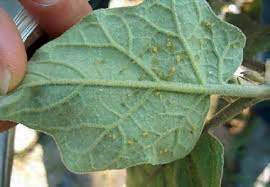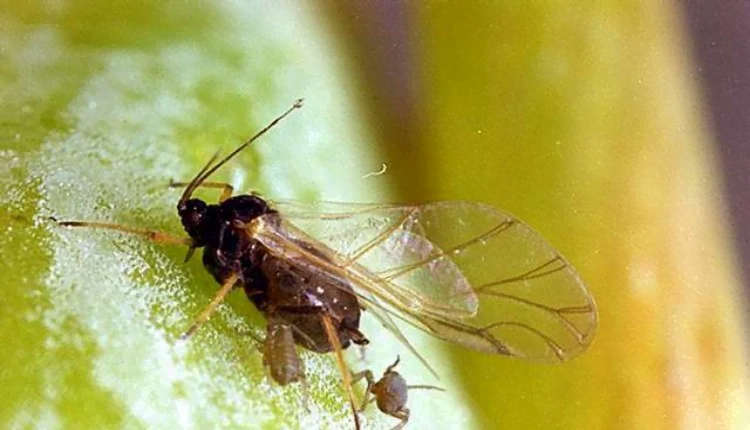Table of contents of the article
Toggle
Eggplant aphid is a common pest that affects eggplant and causes weak plants. In this article on your website, WORLD OF PLANTS, we discuss how to recognize its infestation and ways to combat it.
Aphids on eggplant
Aphis on eggplant is considered one of the agricultural pests that greatly harm the eggplant crop and its economic production, and causes weakness of the fields and the attraction of other pests to the field. What is the most important information about it, and what are the manifestations of infection with aphids on eggplant, and how can the farmer combat aphids on eggplant? ?
The Aphis aphid on eggplant is one of the sucking and piercing insects, Aphidae, that sucks the plant's cellular juices. In doing so, it weakens the plant and prevents it from receiving the products of photosynthesis that the plant performs in order to secure its food. Thus, the yield of the eggplant is reduced and the crop is weakened. Aphids spread in all parts of the world, and they have very large families, including grasses, legumes, cucurbits, tomatoes, cucumbers, eggplants, and others, and a very large number of generations, which makes it difficult to find an integrated control program for them. These insects infect eggplant, threatening the overall yield, and causing economic losses to the farmer, sometimes amounting to 80%.
Symptoms of aphid infestation on eggplant
* Aphids feed on leaves by sucking plant juices, and the infestation is characterized by the presence of scattered infected foci in the field.
* Adult insects and their nymphs are seen on the lower surface of the leaves and the growing apex in severe infestations and when control is neglected. The insects secrete honeydew, where the black mold fungus grows on them, leading to dust adhering to them. The affected plants appear black, causing general plant weakness and the leaves of the daughters dry up, and the daughters may not return to the condition. Natural again.
* When the infection becomes severe, the leaves turn yellow, the efficiency of photosynthesis decreases, and the plants appear weak.
* The fruits are distorted by honeydew, dust sticking to them, and the presence of black fungi on them.
* Ants are found in the honeydew area where they feed on it.
* One of the most dangerous effects of aphids on plants is that they transmit viral diseases to plants, such as mosaic diseases.
Description of aphids on eggplant
This insect is similar to ants, but it is broad and more flattened at the abdomen. It is either winged or wingless. The farmer can easily observe it and watch even the small nymphs form their own colonies as they feed on parts of the eggplant plant: fruits (especially small fruits), leaves, branches, and in general. The whole plant, preferring young and juicy plants.
Aphid infestation on eggplant
Symptoms of aphid infection on eggplant are manifested by:
- Small nymphs and adult aphids attack especially young eggplant branches.
- Insects ferociously suck the juice of young and young branches of eggplants, as well as old ones, as well as leaves and fruits, causing the plant to weaken and become in a state of general weakness.
- Plant tissues die with time, leaves turn yellow and fall, as well as eggplant fruits and flowers that did not succeed in developing into fruits.
- As a result of all of the above, eggplant may not be harvested, and production from the crop may decrease to more than 80%.
- The weakness of the plant itself attracts other dangerous insects, such as eggplant scale insects, fruitworms (eggplant fruitworm, American bollworm), and leafworms (eggplant leafminer).

Life cycle of aphids on eggplant
The life cycle of aphids on eggplant begins with the first generation appearing in cultivated fields in early April in some areas or in May, or even the first winter generation when planted in the winter. After that, the insects mate and new generations appear. With the appearance of the generations, the insects develop from nymphs into full-fledged insects, and then they begin to feed on the sap of the eggplant plant in the leaves, fruits, and branches, and it gradually dies and weakens.
Factors that encourage insect infestation

The most important factors that encourage aphid infestation of eggplant are:
- The farmer's lack of care in planting eggplant at appropriate distances, and planting it at a very high density, which exhausts the plant and deprives it of water, food and air.
- The presence of appropriate temperature and humidity for aphid reproduction in eggplant fields.
- Lack of care in organizing irrigation of eggplant plants, and resorting to incorrect methods of irrigation and exceeding its limit.
- Increase the nitrogen fertilizer, which encourages the growth of juicy plants, especially eggplant leaves and buds, and this is what aphids love.
Control of aphids on eggplant
Aphids on eggplant are controlled through a number of preventive and curative measures.
Preventive control of aphids on eggplant
Prevention is done by planting eggplant at appropriate distances, which are 40 cm between plants and 40 cm between lines, avoiding high density per unit area, using the technique of soluble fertilizers in irrigation water, and not increasing the amounts of nitrogen fertilization per unit area.
Therapeutic control of aphids on eggplant
Aphids on eggplant are permanently treated by using the pesticide gosathion, or malathion (Malathion), or the pesticide Parathion methyl, or the pesticide Dimeton s Methyl, by spraying the branches, fruits, and leaves on the eggplant plant. These mentioned pesticides give effective results in aphid-infested eggplant fields.
Integrated management procedures for aphids on eggplant
Integrated management of the field infected with aphids on eggplant is carried out as follows:
- Separating the cultivation of eggplant from the cultivation of other vegetables, especially legumes, grasses, cucumbers, squash, and others.
- The farmer monitors the eggplant fields periodically in spring and winter by monitoring the leaves, vegetative and fruit collections and ensuring that they are free of aphids and their symptoms.
- The farmer also seeks to get rid of the weeds surrounding the eggplant field, because it ensures that pests can move and hide among the components of these weeds.
- The farmer also depends on balanced fertilization with nitrogen, N, and phosphorus, P (especially potash, K for eggplant, to give the plant an immune boost against pests, including aphids).
- The farmer takes as much care as possible to take general care of the eggplant plants, including irrigation, hoeing, pruning, and other agricultural services. The hoeing is done to a depth of 12-15 cm and repeated three times until the fruit is set and the delicious, ripe fruits are obtained.
In conclusion, we would like to note that we, at the world of plants website, offer you all the necessary services in the world of plants, we provide all farmers and those interested in plants with three main services::-
- Artificial intelligence consulting service to help you identify diseases that affect plants and how to deal with them.
- Blog about plants, plant diseases and care of various crops ... You are currently browsing one of her articles right now.
- An application that provides agricultural consultations to clients, as well as a service for imaging diseases and knowing their treatment for free – Click to download the Android version from Google Play Store، Click to download the IOS version from the Apple App Store.
Sources:




